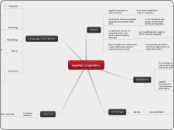Applied Linguistics
refers to
Language
teaching
therefore including
language planning
translation and interpreting
studies
speech therapy
Language Descriptions
Semantics
dealing with the meaning of words, and Language grammatical semantics
how morpheme meanings are combined by grammar to
form the meaning of utterances
that part of linguistic description which deals with meaning,
is often divided into lexical semantics
Syntax
deals with how to put
words together to form sentences which mean what we want
Morphology
deals with the way in which words are made up of morphemes
the smallest meaningful units of language
Phonology
Speech Sounds as a System
each language contains a selection of the possible human speech sounds
the speech sounds are known as phonemes
Phonetics
Transcribing sounds
the sounds of a language are not the same as the letters of a language
even in languages with much less irregularity than English
The study of the sounds that human beings make in their languages
concerned
solving
social problems
use of
language
definitions
Applied
Linguistics’ is using what we know about
(c) how it is used, in order to achieve some purpose or solve some problem
(b) how it is learned
(a) language
the theoretical and empirical investigation of real-world problems
in which language is a central issue” (Brumfit, 1997, p. 93)
History
Much of what can now be seen as groundbreaking applied linguistics type activity
was carried out prior to the formal appearance of applied linguistics
or of linguistics as recognized fields of endeavor
A significant amount of work directed to real-world issues involving language
can be attributed to leading North American linguists,
although notcharacterized as applied linguistics
While North American applied linguistics has evolved over time,
in its orientation and scope, so has North American linguistics.
Applied Linguistics in North America
does have identifiable roots in linguistics.

